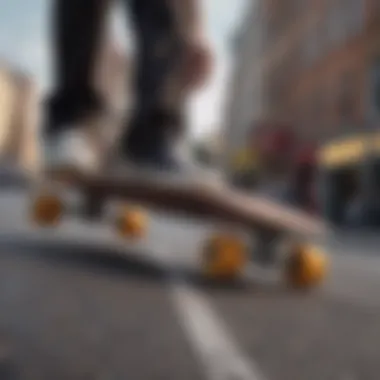Understanding the 9.5 Skateboard: A Comprehensive Guide


Intro
The evolution of skateboarding has seen numerous shifts in design, dimensions, and performance. Among these developments, the emergence of the 9.5 skateboard stands out. This width offers a unique balance between stability and maneuverability, catering to diverse skating styles and skill levels. In this article, we will explore its dimensions, features, and the significance this size holds in today's skating community.
Understanding the 9.5 skateboard involves more than just knowing its measurements. It is essential to recognize how it fits within the larger spectrum of skateboard options available. Whether you're a novice trying to grasp the fundamentals or a seasoned boarder seeking insights into performance nuances, this guide aims to equip you with the knowledge you need to make informed choices.
As we delve into the specifics of the 9.5 skateboard, we will discuss various techniques, gear, safety measures, and the broader context of extreme sports. Each section is crafted to provide valuable insights, allowing you to enhance your experience and skill as a skateboarder.
Preamble to Skateboard Sizing
Skateboard sizing is a fundamental aspect of skating that can significantly influence one’s experience on a board. The dimensions of a skateboard, especially the width, play a critical role in how the board performs during different skating styles. Whether a person is a beginner or an experienced skater, understanding skateboard sizing helps in making informed decisions about which board to choose.
The 9.5 skateboard width is gaining prominence for its versatility. It serves various skating styles, making it an appealing option for many. By examining how board sizes affect balance, stability, and overall maneuverability, skaters can tailor their equipment to match their preferences and skill levels. This exploration within the article aims to clarify misconceptions around board width and establish a clear link between size and performance.
History of Skateboard Development
The evolution of the skateboard reflects the changing dynamics of sport and culture. It began in the late 1940s with surfers wanting to create a new method of experiencing their passion on land. Early skateboards were simple wooden planks with metal wheels. As demand rose, innovations led to changes in materials and design features.
By the 1980s, the skateboarding culture rapidly expanded. Boards became wider, and riders started to develop their styles. The introduction of different shapes, materials, and technologies made skateboarding more accessible to a broader audience. These developments established foundational knowledge on how board dimensions could enhance performance.
Importance of Board Dimensions
Understanding board dimensions is essential for safety and effectiveness in skating. The width of a skateboard can influence balance and foot placement. A 9.5 skateboard, for example, provides a stable platform, which is particularly beneficial for tricks requiring precise foot movements.
- Balance: Wider boards like the 9.5 size promote better weight distribution.
- Stability: They offer increased stability during tricks and landings.
- Personal Preference: Choosing the right width allows skaters to express their style and comfort level.
Defining the 9. Skateboard
Defining what a 9.5 skateboard is involves understanding its dimensions, intended use, and performance characteristics. The 9.5 measurement specifically refers to the width of the board, which has a significant impact on how it handles and performs in various skating situations. This section highlights why this width matters for both new and experienced skateboarders.
A wider skateboard, such as a 9.5, tends to provide greater stability. This characteristic can be particularly beneficial for beginner skaters who may wish for a less daunting experience while learning trick techniques. Additionally, the added width can accommodate more foot space, which allows for a more secure footing. For those engaged in cruising or downhill riding, the extra width provides confidence and balance that can enhance the experience.
As skateboarding continues to modernize, different styles and preferences emerge. The 9.5 skateboard addresses a niche that prefers stability and control, particularly in street and transition skating. It's essential for skaters to recognize that this width may not be suitable for all skating styles, and thus, understanding its definition is crucial to making informed decisions about board selection.
Specifications of a 9. Skateboard
The specifications of a 9.5 skateboard provide a clearer picture of its physical attributes. Typically, the dimensions are complemented by custom features that further enhance performance. Common specifications include:
- Width: 9.5 inches
- Length: Generally ranges from 31 to 33 inches
- Material: Usually constructed from maple wood or bamboo
- Concave: Varies but generally deep for improved grip
- Graphic Options: Available in numerous designs to cater to personal style
These specifications make the board versatile enough for different types of tricks and maneuvers. The width not only supports balance but also allows skaters to land tricks more smoothly, distributing weight evenly upon landing. This feature creates a more forgiving surface when approaching ramps or rough terrains.
The Relationship Between Width and Performance
The relationship between width and performance in skateboarding is significant. A wider board offers specific advantages, especially for those who prioritize stability during tricks. Skaters can execute movements with more confidence when their feet are better positioned, and this width facilitates smoother transitions when carving or turning.
When considering performance, skaters may experience:


- Enhanced Stability: The 9.5 width provides a larger surface area, which aids in balance during tricks.
- Easier Trick Execution: For tricks that require landing precision, the width helps in stabilizing the board upon impact.
- Control during Speed: Skating downhill or at high speeds becomes less daunting due to improved grip and control.
However, it is essential to note that some skaters may find the width cumbersome, particularly if they are used to narrower boards. The choice of board width should ultimately reflect personal preference and style. Understanding the performance implications will help in selecting the right skateboard for individual needs.
"Choosing the right skateboard width can make all the difference in your skating experience, balancing performance and stability."
Comparing Skateboard Widths
Skateboard width is a crucial element that influences various aspects of your skating experience. Different widths serve unique purposes, making it important to understand these when selecting a board. As skateboarding styles continue to evolve, so do the choices available. The 9.5-inch width stands out as a versatile option, suited for both beginners and experienced riders. This section will explore typical skateboard widths, the advantages of a 9.5 width, and when it may be necessary to consider other widths.
Typical Skateboard Widths
Skateboards generally fall within a range of widths. The typical skateboard widths are as follows:
- 7.5-8.0 inches: Commonly used for street and technical skating. These narrower boards are more agile, allowing for quick flips and tricks.
- 8.0-8.25 inches: The standard width for many skateboarders. It strikes a balance between stability and control, making it a popular choice across various styles.
- 8.25-8.5 inches: Often preferred for street and ramp skating; provides more surface area for tricks while still maintaining maneuverability.
- 8.5-9.0 inches: This width offers a blend of stability and performance, suitable for larger skaters or those pursuing transition and bowl skating.
- 9.0-9.5 inches: Here is where the 9.5-inch skateboard fits in, attracting a mix of street and transition riders seeking a stable platform.
Selecting the right width is essential as it can affect your balance and comfort while riding.
Advantages of a 9. Width
The 9.5 skateboard width features several key advantages that appeal to various skaters:
- Increased Stability: A wider board provides a stable platform, helping to maintain balance during tricks and turns.
- Better Foot Placement: The extra space allows for more control over your feet, enhancing your ability to perform complex maneuvers.
- Versatile Applications: Riders can engage in multiple skating disciplines, from street skating to ramp riding, due to the adaptable nature of the 9.5 width.
- Enhanced Confidence: Beginners may find a wider board less intimidating, fostering confidence in starting to learn tricks.
Moreover, its width allows for greater surface area, which can be beneficial when landing jumps or performing slides.
When to Consider Other Widths
While the 9.5 skateboard width offers various benefits, there are scenarios where alternate widths may be more suitable:
- Narrow Boards for Technical Skills: If a skater is focused on street skating and technical tricks, a narrower board, such as 8.0 or 8.25 inches, may provide better flick and mobility.
- Larger Riders: Heavier or taller riders may find that wider boards above 9.5 inches offer even more stability than the 9.5 size.
- Specific Skating Styles: Transition and vert skaters might prefer a width of 9.0 to 9.5 or larger, making it easier to navigate large ramps and bowls.
It is vital to match board width to personal skating style and individual preferences. Each skater has unique requirements, which should guide the selection process.
In skateboarding, choosing the right width not only influences your performance but also impacts your enjoyment of the sport. It is essential to find a board that aligns with your skill level and style.
Understanding skateboard widths enables skaters to make informed decisions. With the knowledge gained from this section, those looking to use a 9.5 skateboard can appreciate its advantages and know when to explore other options.
Skating Styles and the 9. Skateboard
The 9.5 skateboard is not just a mere dimension; it plays a significant role in shaping the skating experience. Understanding the skating styles that best complement this width is crucial for both new and seasoned riders. The relationship between board width and skating style involves several factors such as balance, stability, and maneuverability. Each style of skating has its own demands, and the 9.5 inch board offers unique advantages that can enhance performance.
Street Skating with a 9. Board
Street skating often requires boards that balance durability and performance. A 9.5 skateboard provides ample surface area for tricks such as grinds and flips. This width can help with footing, allowing skaters to maintain stability when executing complex maneuvers. Wider boards can absorb impacts better, which is especially important when practicing in urban environments where obstacles are frequent.
However, the increased width may also limit the ability to perform quick, tight turns compared to narrower boards. Skaters who frequently navigate busy streets might want to weigh these factors carefully.


Transition and Vert Skating
When it comes to transition and vert skating, a 9.5 board proves advantageous. The additional width helps with stability during tricks that require a higher level of control, such as airs and carves on ramps or quarter pipes. Riders often prefer wider boards in this style for increased confidence when transferring weight in the air.
Furthermore, the 9.5 skateboard can offer better balance while grinding on coping or ledges. Riders will often find that their landings are more secure with this type of width, which can enhance both performance and safety.
Freestyle Options for Wider Boards
The 9.5 skateboard opens up new avenues for freestyle skating. While traditional freestyle boards are narrower, a wider option can help perform certain tricks, including slides and flips with greater ease. The board's surface provides more real estate for foot placement, aiding in balance during tricky maneuvers.
However, it is essential to recognize that freestyle skating often involves quick turns and flips, and a wider board can hinder these actions. As a result, those who choose a 9.5 skateboard for freestyle should practice adaptability in their skating techniques.
The 9.5 emphasizes stability and control in various skating styles, proving to be a versatile choice for many skaters.
Choosing the Right 9. Skateboard
Selecting the appropriate skateboard is crucial for optimal performance and enjoyment on the board. A 9.5 skateboard can provide unique advantages, particularly in stability and control. However, to fully benefit from these advantages, it is essential to consider various factors like skill level, materials, and brand reputation. These elements significantly influence how well a skateboard will perform and how comfortable it will feel underfoot.
Understanding Your Skill Level
Your skill level plays a vital role in determining the best skateboard for you. Beginners may find a wider board like the 9.5 skateboard more forgiving. Wider decks provide additional stability, which is helpful for tricks and maneuvers. However, more advanced skaters might prefer a narrower board for increased agility and responsiveness during high-speed runs or technical tricks.
- Beginners: If you are just starting, a 9.5 skateboard can instill confidence. Its surface area aids in balance and control. You may find it easier to learn fundamental skills, such as pushing and carving.
- Intermediate and Advanced Skaters: These skaters may have specific preferences for narrower boards that enhance performance in certain styles like street skating or vert. However, those looking to transition or freestyle might appreciate the room a 9.5 board offers.
Material Considerations
The choice of material directly affects the skateboard's flexibility, durability, and overall performance. Most skateboards use maple or a combination of woods, with bamboo and fiberglass also being popular in some models.
- Maple Wood: Known for its rigidity, maple is a common choice in skateboard construction. A 9.5 skateboard made from high-quality maple delivers excellent pop and durability.
- Bamboo: This lightweight material adds flexibility, making it suitable for cruising and casual riding. Some wider boards may combine maple and bamboo to provide both stability and flexibility.
- Fiberglass Reinforcements: Incorporating fiberglass can enhance the strength of the board without adding weight. This feature may be important for skaters who perform tricks that require both strength and lightness.
Understanding these materials can help you choose a 9.5 skateboard tailored to your riding style and preferences.
Brand Recommendations
Choosing the right brand can also determine your satisfaction with a skateboard. Various companies are recognized for their quality and reputation in the skateboarding community. Here are some brands to consider when selecting a 9.5 skateboard:
- Baker Skateboards: Known for their sturdy boards with great designs, Baker offers reliable options for various skill levels.
- Element Skateboards: Element focuses on eco-friendly materials, and their boards are often versatile for street and park skating.
- Creature Skateboards: This brand is recognized for creating durable skateboards that handle well, making it suitable for aggressive skaters.
- Plan B Skateboards: With a focus on performance and quality craftsmanship, Plan B boards are built for durability and provide good grip.
Each of these brands presents various 9.5 skateboard models tailored to different skaters' needs. When making a final decision, consider factors such as your style, local skate scene, and personal preferences.
Maintenance and Care for Your Skateboard
Taking care of your skateboard is as important as choosing the right one. Regular maintenance can extend the life of your skateboard, enhancing its performance and ensuring safety during rides. Neglecting proper care may lead to parts wearing out prematurely or even accidents due to equipment failure. Thus, understanding maintenance practices is crucial for all skateboarders, whether new or experienced.
Routine Checks and Maintenance
Routine checks are about staying proactive with your skateboard. Regular inspecction of various components can help identify potential issues early. Here are key areas to focus on:


- Wheels: Inspect for uneven wear, chips, or cracks. They should roll smoothly without wobbling.
- Truck: Check tightness of bolts and the axle to ensure stability. Loose trucks can affect control.
- Deck: Look for any cracks or delaminations. A compromised deck can break under stress, risking injury.
- Grip Tape: Ensure that it is still intact and provides good traction. Replace it if it wears down too much.
A basic maintenance schedule might include checking your skateboard at least once a week, or after every few rides. This creates a habit of care and helps catch minor issues before they escalate.
Replacing Components of Your Skateboard
Eventually, some skateboard components will need replacement. Knowing when and how to replace them is vital. Here are common components that degrade over time and guidelines for replacement:
- Wheels: Most wheels need to be replaced after significant wear or if they chip. Signs of wear include flat spots or excessive cracks.
- Bushings: If you notice decreased responsiveness in turning, it might be time to replace bushings. This component affects the smoothness of your ride.
- Bearings: Bearings also need attention. Regular cleaning can extend their lifespan. However, if they become too slow or noisy, replacement is necessary.
The replacement process does not have to be complicated. Most skateboard parts are widely available, and tutorials can be found online. Familiarize yourself with the assembly and disassembly of your skateboard for smooth maintenance.
Regular maintenance of your skateboard not only enhances its performance but also ensures a safer and more enjoyable riding experience
By prioritizing routine checks and being prepared for component replacements, skateboarders can enjoy their sport with fewer interruptions and a higher level of safety. Taking these steps turns maintenance into a vital part of your skating routine.
The Community and Culture Around Skateboarding
The community and culture surrounding skateboarding are vital to understanding the sport's identity and evolution. This culture is built on shared experiences, mutual respect, and the artistry that comes with skateboarding. It not only fosters a sense of belonging but also promotes growth and innovation within the sport. Engaging with this community can enhance the skating experience, providing opportunities for learning and socializing while pushing riders to achieve new heights in their skills.
Exploring Skate Parks
Skate parks serve as the epicenters of skateboarding culture. These spaces are designed specifically for skaters to practice and showcase their abilities. They vary widely, from simple ramps to complex bowls and street-style features that mimic urban environments. Visiting skate parks provides numerous benefits:
- Skill Development: Riders can experiment with new tricks in a safe environment. Access to diverse structures helps them learn, practice, and refine their techniques.
- Social Interaction: Skate parks are natural meeting points for skateboarders. Here, individuals can connect and build friendships over their passion. They might even find mentors who can offer guidance.
- Event Hosting: Many skate parks host competitions and events, allowing participants to showcase their skills and gain exposure. These events encourage camaraderie among skaters and foster a spirit of healthy competition.
In addition, skate parks often reflect local trends in skating. They can reveal what styles or tricks are popular, offering insights into evolving skate culture.
Connecting with Other Skateboarders
Connecting with fellow skateboarders is as important as mastering tricks. Sharing experiences and knowledge within the community fosters personal growth and increases motivation. Online platforms and social media play a crucial role in enhancing these connections. Here are some ways to engage:
- Local Events: Participate in or attend local skateboarding events, such as competitions or community meet-ups. These gatherings foster relationships with other skaters and can lead to collaborations or trick exchanges.
- Social Media: Platforms like Reddit or Facebook have dedicated groups where skateboarders share tips, experiences, and even videos of their performances. Engaging with these communities can provide vital feedback and support.
- Collaborative Projects: Many skateboarders create video projects or blogs to document their journeys. Collaborating on such initiatives can deepen connections and broaden one’s perspective on skating.
Closure
The conclusion of this guide serves to tie together essential elements of understanding the 9.5 skateboard. It is crucial because it reinforces the key findings from the discussions on dimensions, performance, and suitability for various styles of skating. Recognizing these aspects allows skaters to make informed choices tailored to their preferences and needs.
Recap of Key Points
In brief, there are several critical takeaways from this article. The 9.5 skateboard functions well across multiple skating styles, offering both stability and maneuverability. Skating with this width can cater to both novice and experienced skateboarders who are looking for versatility. Additionally, the specifications and material considerations discussed earlier are essential in selecting a quality board that will withstand wear and enhance performance.
- Versatility: The 9.5 width excels in street, transition, and freestyle skating.
- Performance: Skaters notice enhanced stability and control.
- Material Matters: Choosing the right materials impacts durability and ride quality.
These highlights showcase the importance of understanding board dimensions in relation to personal skating style.
Future Trends in Skateboard Design
As the skateboarding industry evolves, several trends are emerging that influence skateboard design. Innovations in materials, such as carbon fiber and bamboo, are becoming more prevalent. These materials not only enhance durability but also improve the overall ride experience. Additionally, there is growing interest in environmentally friendly practices. Manufacturers are looking into sustainable options to reduce the environmental impact.
Furthermore, technology integration, like sensors to track skateboarding performance, is also on the rise. These advancements can provide valuable insights for skaters aiming to improve their skills. With a focus on both performance and sustainability, the future of skateboard design looks promising for skaters of all levels.
"Understanding the dimensions, materials, and future innovations in skateboarding opens a new perspective for every enthusiast."
Overall, a comprehensive understanding of the 9.5 skateboard not only enhances the skater's ability to choose the right board but contributes to a richer skateboarding experience.







